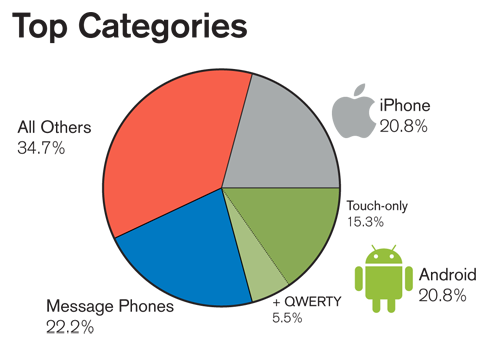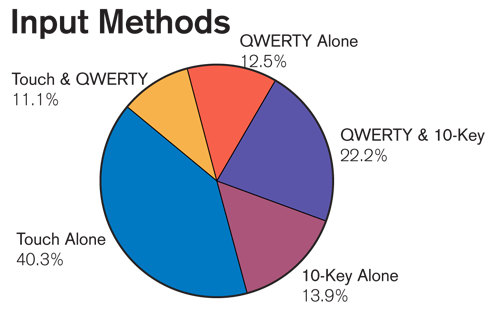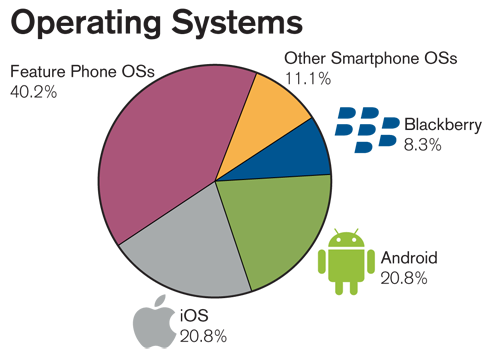"If you watch the phones people display in public, you really see only two in large numbers: iPhone and BlackBerry."I am sure that can be parsed to be technically true, but I hear a lot of comments along these lines. And with a popular developer mentality of making products for yourself, then your friends, and users who matter will come as they may, I am saddened by this. I have even heard non-technical (not mobile designers or developers, I mean) folks being given crap by their non-technical friends (same definition) for having an "old scool" phone, when it does perfectly good internet, email, etc. It's just not the latest favorite smartphone.
So, I was looking around one day exactly a month ago, and realized I am looking at all sorts of phones in people's hands. So, it's that simple. I started recording them. Every handset I even sorta could identify, I recorded. The methodology I used was:
- It has to be already visible. No asking everyone in the room to pull out their phones. This gives the observed weighting that everyone seems interested in. There's some "that's what they use" thing that implies everyone else's phones are unimportant. I have actually had conversations where people dismissed sales numbers.
- I discounted my family, and all work friends. And their immediate families.
- If it's clearly a phone, it gets recorded. This makes for some vague labels on some of them. I can recognize a half dozen handsets at 100 paces. Others are "flip phone" at all but contact range. So, you'll see some oddly vague data. But this is to avoid my own bias on recognizing phones I have or use or read about all the time.
- I started to record cameras, music players, etc. It got out of hand. Just let it be known that convergence is not as far as I would have thought. A LOT of people carry other devices, and almost everyone who wants to take photos brings dedicated cameras to events they know are gonna happen. Very, very little cameraphone use at school concerts. A few Kindles observed also, but no other readers, no iPads.
- No demographics. Partly, to make it easy. I was typing these into my phone while doing other things. Partly because I don't have the capability to bother everyone to fill out a survey. I would worry about my own bias therefore, so didn't gather any.
- Yes, it's local. Kansas City and nearby areas. If you think we're all rubes, blow me. Go ahead and design for your friends in the bay area, and stop reading now.
- This is only 72 total devices. Take that as you will.


 All the data I used is available for you to mock and laugh at. Or, I guess, add to. If anyone likes this, go ahead and continue the experiment. Vector versions of the charts above can be downloaded as well.
I think most of this is clear, but one definition is sort of mine alone. The Message Phone the stupendously common QWERTY device, usually with a slide-out keyboard, and some controls (usually a full 10-key pad) when closed. Sure, other devices and even many smartphones share these features, but for here, I am calling it only featurephones. Note that these are not counting as touch, since it's impossible to tell that at a glance, but some huge percentage of them are indeed touch devices as well. They often are pretty neat, with nice keyboards, good haptic feedback, perfectly good screens, multi-day battery life, etc.
Note that iPhone and Android are neck and neck. And message phones slightly outsell those. Hmm... Oh, and check out that last one. Other devices outsells all others. Sure, it's a mishmash, but don't say any one thing is dominant when it's easy to make charts like this.
Anyway, as far as validity, I always say that crappy, cheaply-done research that broadly backs serious, heavy research is trustworthy. Nothing here is totally surprising and much hews exactly to known sales or use ratios, so I do tend to believe it.
So, what's this all mean? Simple. There are a LOT of devices out there, and people use them. Look at the data and see what is really going on. More importantly, look at real data and make sure you look at your own users, and your analytics the right way.
But what if 96% of your traffic is coming from iPhone? Well, I'd be suspicious of the analytics first of all. Seriously, I've seen this way more than once. If you sell anything but iPhone apps and get that sort of traffic, then first be suspicious and make sure you are getting the right information.
All the data I used is available for you to mock and laugh at. Or, I guess, add to. If anyone likes this, go ahead and continue the experiment. Vector versions of the charts above can be downloaded as well.
I think most of this is clear, but one definition is sort of mine alone. The Message Phone the stupendously common QWERTY device, usually with a slide-out keyboard, and some controls (usually a full 10-key pad) when closed. Sure, other devices and even many smartphones share these features, but for here, I am calling it only featurephones. Note that these are not counting as touch, since it's impossible to tell that at a glance, but some huge percentage of them are indeed touch devices as well. They often are pretty neat, with nice keyboards, good haptic feedback, perfectly good screens, multi-day battery life, etc.
Note that iPhone and Android are neck and neck. And message phones slightly outsell those. Hmm... Oh, and check out that last one. Other devices outsells all others. Sure, it's a mishmash, but don't say any one thing is dominant when it's easy to make charts like this.
Anyway, as far as validity, I always say that crappy, cheaply-done research that broadly backs serious, heavy research is trustworthy. Nothing here is totally surprising and much hews exactly to known sales or use ratios, so I do tend to believe it.
So, what's this all mean? Simple. There are a LOT of devices out there, and people use them. Look at the data and see what is really going on. More importantly, look at real data and make sure you look at your own users, and your analytics the right way.
But what if 96% of your traffic is coming from iPhone? Well, I'd be suspicious of the analytics first of all. Seriously, I've seen this way more than once. If you sell anything but iPhone apps and get that sort of traffic, then first be suspicious and make sure you are getting the right information.
1 comment:
Oh, one thing I sorta gathered and didn't talk about is cases. Almost all iPhones were cased, very few others were... or maybe they were. I know that the message phone key demo is tweens and moms and they like fashion, so sell a lot of color back accessories. But... I couldn't tell as easily as with the smartphones. So I left it out.
I would, however, love to explore this some day. It seems that almost no one is worried about breaking their various Androids, but the iPhone is perceived as very fragile so needs a case. That, or it's ugly and everyone wants a fashion accessory? Weird either way, and if I was an ID at Apple, I'd want to know why everyone covers up my pretty phone.
Post a Comment